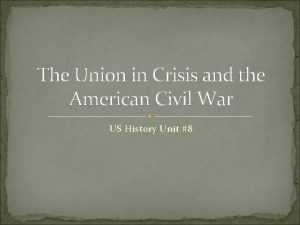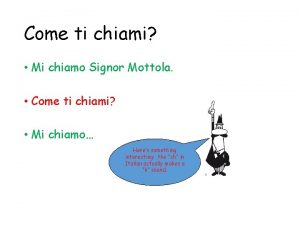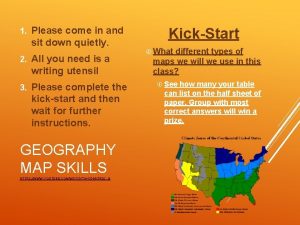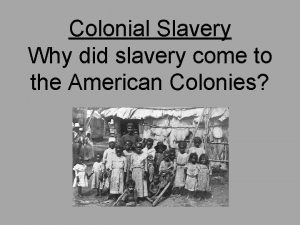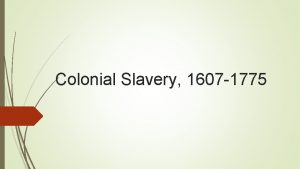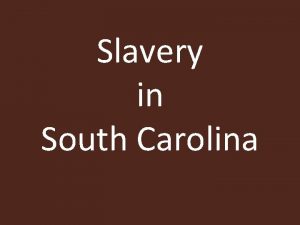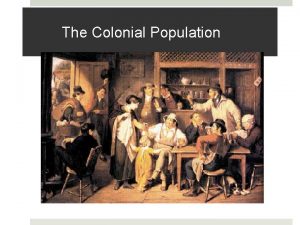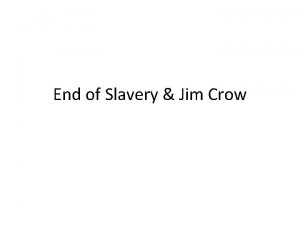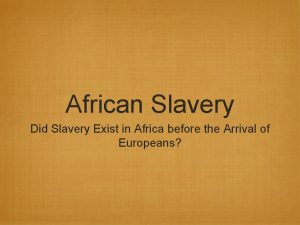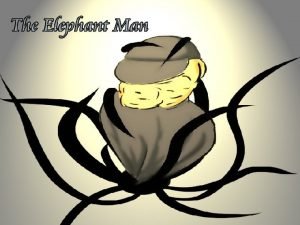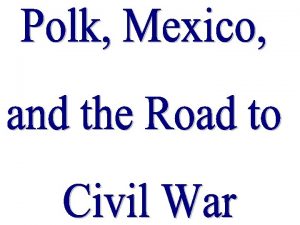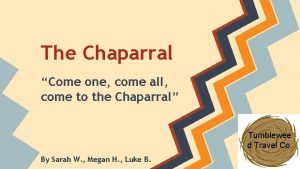Colonial Slavery Why did slavery come to the






















- Slides: 22

Colonial Slavery Why did slavery come to the American Colonies?

Initially, slavery was not the dominant system of labor for the colonies. It was Indentured Servitude. q. Headright System: System Plantation owners were given 50 acres for every indentured servant they sponsored to come to America from Europe. q. Indentured Contract: Contract Served plantation owner for 7 years as a laborer in return for passage to America. q. Freedom Dues: Dues Once servant completed his contract, he/she was freed…. They were given land, tools, seed animals. However, they did not receive voting rights.

Bacon’s Rebellion (1676 - 1677) Nathaniel Bacon represents former indentured servants. Governor William Berkeley of Jamestown

• Involved former indentured servants • Not accepted in Jamestown • Disenfranchised and unable to receive their land • Gov. Berkeley would not defend settlements from Indian attacks

• Nathaniel Bacon acts as the representative for rebels • Gov. Berkeley refused to meet their conditions and erupts into a civil war. • Bacon dies, Gov. Berkeley puts down rebellion and several rebels are hung Consequence of Bacon’s Rebellion Plantation owners gradually replaced indentured servants with African slaves because it was seen as a better investment in the long term than indentured servitude.

• Slavery introduced by the Spanish into the West Indies after Columbus’s discovery of America. • Spanish and Portuguese expanded African slavery into Central and South American Slaves captured in Africa after enslaved Indians began dying off. • In 1619, the first recorded introduction of African slaves into what would become the United States was in the settlement of Jamestown……Only 20 slaves were purchased…. Slaves aboard ship—Middle Passage

Why Not Enslave the Native Population? • Native Americans were highly likely to catch European diseases. • They were familiar with the terrain and could escape easier. • They had political allies that could fight against the “owners. ”

Reasons for Using Enslaved African Labor • Proximity-It only took 2 -6 weeks to get to the colonies from the Caribbean at first. • Experience-They had previous experience and knowledge working in sugar and rice production. • Immunity from diseases-Less likely to get sick due to prolonged contact over centuries. • Low escape possibilities-They did not know the land, had no allies, and were highly visible because of skin color.

Exit Slip #1 Slavery 1. Who or what was used in place of slavery in the United States for the labor force in the 1600’s? 2. What was Bacon’s rebellion over? 3. Name the place where slavery was introduced first. 4. When and where was slavery introduced to the United States? 5. Explain the reason for using African slaves instead of Native Americans.

The Triangular Trade • New England merchants gain access to slave trade in the early 1700 s 1. Rum brought to Africa, exchanges for slaves 2. Ships cross the Middle Passage, slaves trades in the West Indies. • Disease, torture, malnourishment, death for slaves 3. Sugar brought to New England • Other items trades across the Atlantic, with substantial profits from slavery making merchants rich

Manufactured Goods • Furniture • Clothing • Colonials had not factories. From England to Colonies

This is called the Middle Passage

Middle Passage • http: //youtu. be/Tg. TGi. We. RCWc

Destination, Auction, and Seasoning • Most Africans landed in Brazil with the least number landing in North America. • Slaves were auctioned off to the highest bidder. • Slaves were put through a process of “seasoning” to get them ready for work. • They learned an European language, were named an European name, and were shown labor requirements.

Slavery and the Colonies • Slavery in the North – Since the economics of New England the Middle Colonies were based on small farms, slavery was far less important – Given that slaves were few and posed little threat to the white majority, laws were less harsh than in the South – Slaves did represent a sizable percentage of urban laborers, particularly in New York and Philadelphia

Slavery in the Colonies • New England colonies-no large plantation systems; slaves lived in cities and small farms • Chesapeake Bay colonies (NY, Penn, WV, Virg, Delaware)-large tobacco plantations; center of the domestic slave trade • Carolinas and Georgia-large rice and cotton plantations

Slavery and the British Empire Slave Systems in the English Colonies – Three distinct slave systems were well entrenched in Britain’s mainland colonies • Chesapeake • South Carolina and Georgia • Non- plantation societies of New England the Middle Colonies – Chesapeake slavery was based on tobacco – Chesapeake plantations tended to be smaller and daily interactions between masters and slaves were more extensive



• Slaves resorted to revolts in the 13 colonies and later in the southern U. S. • 250 insurrections have been documented; between 1780 and 1864. • 91 African-Americans were convicted of insurrection in Virginia alone. • First revolt in what became the United States took place in 1526 at a Spanish settlement near the mouth of the Pee Dee River in South Carolina. Slave Revolts

Slave Revolts would lead plantation owners to develop a series of slave laws/codes which restricted the movement of the slaves. • Slaves were not taught to read or write • Restricted to the plantation • Slaves could not congregate after dark • Slaves could not possess any type of firearm • A larger slave population than white in some states Slave owners wanted to keep their slaves ignorant of the outside world because learning about life beyond the plantation could lead to more slave revolts and wanting to escape. Slave Laws

Exit Slip #2 Slavery 1. What was triangular trade in the 1600’s? 2. What was the middle passage of triangular trade route? 3. Explain how slavery was in the northern part of the United States? 4. Describe slavery in the colonies in terms of how slaves were used. 5. List where the slave revolts started and the places they occurred.
 Colonial slavery apush
Colonial slavery apush Come rico come sano come pescado
Come rico come sano come pescado Andreas carlsson bye bye bye
Andreas carlsson bye bye bye How did bleeding kansas embody the slavery controversy
How did bleeding kansas embody the slavery controversy Why did annemarie choose this particular fairy tale
Why did annemarie choose this particular fairy tale Dont ask
Dont ask Come holy spirit dove divine
Come holy spirit dove divine Come on hey
Come on hey Come thou fount come thou king lyrics
Come thou fount come thou king lyrics Past and past participle of fall
Past and past participle of fall E m m a n u e l
E m m a n u e l Come mi chiamo?
Come mi chiamo? Through all generations everlasting is his mercy
Through all generations everlasting is his mercy Come home come home jesus is calling
Come home come home jesus is calling Vorrei essere al mare
Vorrei essere al mare Turn on your radio
Turn on your radio Come mi chiamo come mi chiamo
Come mi chiamo come mi chiamo Pasado simple de come
Pasado simple de come Come in and sit down
Come in and sit down Come in come in and sit down
Come in come in and sit down Hát kết hợp bộ gõ cơ thể
Hát kết hợp bộ gõ cơ thể Lp html
Lp html Bổ thể
Bổ thể



